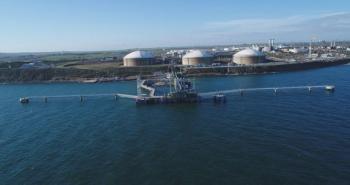
At PowerGen 2023: The Case for Ammonia
An alternative method to global decarbonization
Charlie Green, Solution & Business Development at IHI, and Jeffrey Goldmeer, Emergent Technology Director – Decarbonization at GE Gas Power, presented on ammonia as a zero-carbon gas turbine fuel source at PowerGen 2023. There are various challenges associated with transportation and storage that must be considered. GE and IHI’s study focused on the use of ammonia in gas turbines, comparing it to hydrogen and/or ammonia reverted to hydrogen. The presentation discussed the results of the study, including advantages and challenges from technical and economic perspectives.
Green spearheaded this technical session. The problem GE and IHI were seeking to address through the study of ammonia was global CO2 emission reduction. Specifically, how the problem can be tackled at a regional basis. Certain areas of the world do not have access to the same supply chains as others, or the cost of accessing those materials is cost prohibitive for a realistic decarbonization pathway. Coupling demand and supply forms the global energy economy. Japan, as one example, exists as a standout for renewable implementation. Potential and/or access to renewable infrastructure is a big selling point for the case of ammonia, and many Asian countries look to it as a way forward. This also includes India and China, countries that face similar issues. Making use of existing infrastructure is a priority in these locales.
Essentially, ammonia takes the place of what hydrogen would be doing in other circumstances. This turns out to be very interesting due to the advantage ammonia has over hydrogen as a net-zero carbon fuel solution—the most important of which is its capability to persist long distances with less effort. It can also be converted to hydrogen, which provides an economic pathway to its implementation. Since the gas is less dense, it’s much less of a hassle for countries with limited access to resources to use in order to reach goals of decarbonization.
Goldmeer reviewed the value side of the study. The base cost of hydrogen was considered. There were a multitude of factors at play for cost analysis, such as transportation over land, conversion, liquefication, storage, sea transport, port storage, and reconversion. There were three potential pathways: all ammonia, all hydrogen, or converting back to hydrogen for end use. Ammonia had a lower landed cost as opposed to hydrogen. Liquified natural gas (LNG) in tandem with carbon capture and storage (CCS) showed to be competitive in terms of cost due to infrastructure for lowering carbon emissions. Transportation was noted as the largest cost driver due to fuel prices.
Newsletter
Power your knowledge with the latest in turbine technology, engineering advances, and energy solutions—subscribe to Turbomachinery International today.




